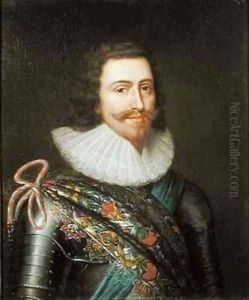Balthazar Gerbier Paintings
Sir Balthazar Gerbier, born Balthazar Gerbier d'Ouvilly, was a versatile figure in the 17th century, known not only as an artist but also as an architect, diplomat, and spy. Born in Middelburg in the Netherlands in 1592, Gerbier was of Huguenot heritage, which influenced his movements and career, especially during the periods of religious turmoil that characterized the era.
Gerbier moved to England in the early 1610s, where he became an agent for Charles I and the Duke of Buckingham. His role extended beyond that of a court painter to that of a diplomat and a spy, as he was often involved in various diplomatic missions across Europe. His artistic endeavors were influenced by his time in the court and the patronage he enjoyed. Gerbier was knighted in 1628, which was a testament to his importance and influence at the English court.
As an artist, Gerbier is not as well remembered as some of his contemporaries, such as Peter Paul Rubens, whom he worked with and for whom he acted as an agent in England. His works included portraits and architectural designs, and he was involved in the design of Charles I's Queen's House in Greenwich, although the extent of his contribution is a matter of some debate among historians.
Gerbier's career as a diplomat was quite active; he was instrumental in negotiating the marriage between Charles I and Henrietta Maria of France. Throughout his life, he remained closely connected to the royal court, and his fortunes rose and fell with those of his patrons. After the execution of Charles I in 1649, Gerbier found himself in a precarious position but managed to adapt to the changing political landscape, although he never regained his former influence.
Sir Balthazar Gerbier died in 1663, having lived through some of the most tumultuous periods of English history, including the English Civil War and the Interregnum. Despite his involvement in many historical events, his legacy today is primarily as a minor figure in art history, overshadowed by the more renowned artists of his time. However, his contributions to the English court and his multifaceted career as a diplomat and spy make him a fascinating character in the rich tapestry of 17th-century Europe.
